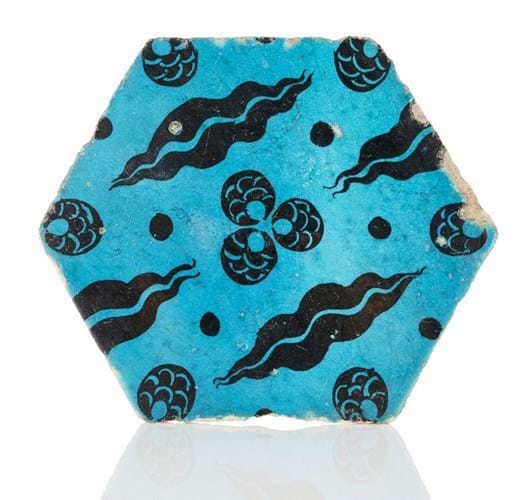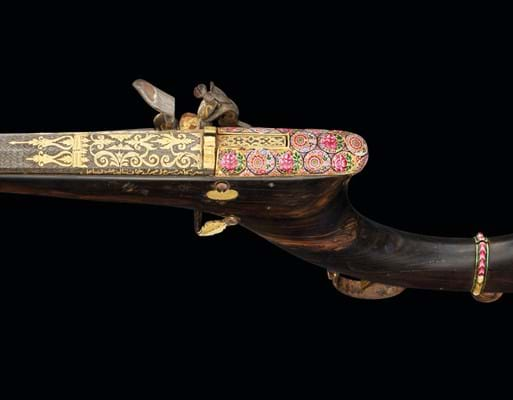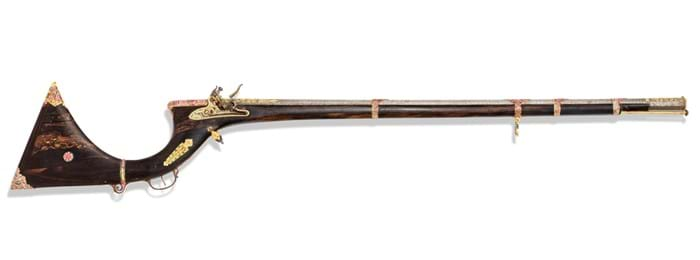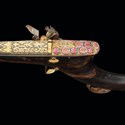1. 16th century Ottoman tile – £88,000
The Antiquities, Indian & Islamic Arts sale at Roseberys on October 28 was topped, at an unexpected £88,000, by a rare 16th century tile from Ottoman Syria.
Around 12in (29cm) across and painted in black under a transparent blue glaze, it is decorated with one of the most recognisable Ottoman decorative motifs – the çintamani pattern.
Pairs of wavy lines and groups of three dots represent the pelts of the striped tiger and spotted leopard that came to evoke strength and power. Tiles of this design were used c.1550-1600 in the decoration of various private apartments in the Topkapi palace in Istanbul.
This example came for sale from the estate of costume designer Anthony Powell (1935-2021) with an estimate of £3000-4000.
2. Gold-inlaid flintlock jezail – £130,000
Christie’s sale titled Art of the Islamic & Indian Worlds on 27 October included this magnificent flintlock jezail c.1823-33. In addition to an English lock with gold-inlaid decoration signed JJ Wilkenson, it featured an octagonal barrel with gold damascened rococo designs and a series of spectacular enamelled gold mounts. On the left-hand side of the barrel in cursive script reads Sarkar Mir 'Ali Murad Khan Talpur, help O 'Ali!
The Talpurs were known as connoisseurs of fine weapons. The inscription reveals this gun was made for one of the ruling amirs of Khairpur province, in Upper Sind. Mir ‘Ali Murad Khan Talpur (b.1815), became closely linked to the British and was allowed to retain Khairpur after the annexation of Sind in 1843. The identification of the inscription Kandawala on the butt plate is not clear, but it may be the name of an official or a treasurer.
Estimated at £100,000-150,000 and sold at £130,000, this is one of a small number of very finely decorated guns made for a few members of the Talpur family. Further known examples include one in the Metropolitan Museum of Art, New York, two in the Khalili collection and two in the al-Thani Collection, Qatar,
3. Seljuk bronze incense burner – £9000
A European single owner collection focusing on the arts of Iran was offered by Chiswick on October 28 and proved a ‘white glove’ event with all of the 89 lots finding buyers.
Some fine pieces of metalwork were led by a 9in (22cm) incense burner in the form of a lion made in eastern Iran or Afghanistan in the 11th or 12th century. Such zoomorphic openwork bronze incense burners are perhaps the best-known metalwork creations of the Seljuk period in Iran. Felines appear to have been the most popular subjects although birds of prey were also a common form. The head and neck of this example are a later addition while the floriated tail shows areas of resoldering and may be a replacement.
However this was amply reflected in the guide of £3000-5000 and it sold for £9000.
4. Indian miniature c.1720 – £125,000
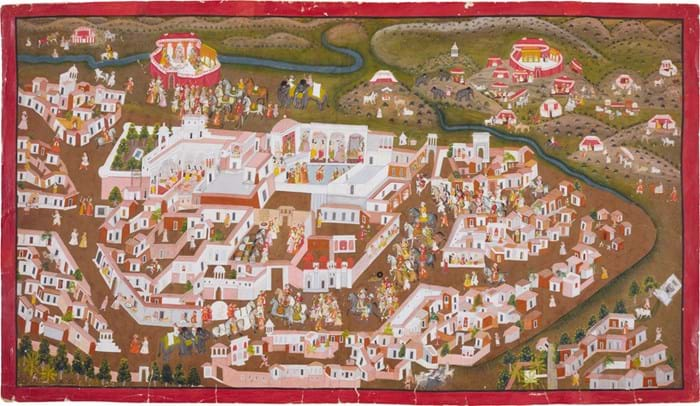
The Pilgrimage of Maharana Sangram Singh of Mewar, an Indian miniature c.1720 – £125,000 at Sotheby’s.
Sotheby’s Arts of the Islamic World & India auction on October 26 included 15 Indian paintings from the collection of Betsy Salinger. The selection, not seen on the market in decades, crossed centuries and styles, spanning outstanding Mughal folios to the distinctive styles of the Pahari, Rajasthani, Mughal and Deccani schools and court ateliers.
Among the highlights was this 47 x 86cm gouache heightened with gold on paper titled The Pilgrimage of Maharana Sangram Singh of Mewar. Painted in Udaipur c.1720-30, it commemorates a historic royal pilgrimage made to the temple and shrines in Nathdwara, perhaps during the month of Chaitra when the gold clad image of Srinathji is worshipped.
Impressive both for its large-scale and the complexity of the composition, it adopts a near aerial viewpoint as it follows the Maharana's grand visit through a town that bustles with daily life. To the reverse is a Mewari royal inventory number and a five-line devanagari inscription reading At Nathdwara, Maharana Sangram Singh at the temple of Shrinathji with Gosain ji crossing the river. After darshan, he returns to the kingdom.
Estimated at £80,000-120,000, it took £125,000.
5. Iznik jug from c.1570 – £700,000
This rare and visually striking jug c.1570 has the coloured ground that featured on only a few Iznik wares from the 1550s. At this time potters in Iznik employed a variety of coloured slips as ground colours. The technique was used to create a red and this lavender although neither was widely used.
The 9in (23cm) jug, last sold at Sotheby’s in 1991, has a number of collection stickers on the base including one reading Lent by Kelekian No.129 – a reference to the collection formed by the influential dealer New York and Paris dealer Dikran Garabed Kelekian (1868-1951).
It had an estimate of £120,000 180,000 at Christie’s sale of Art of the Islamic ad Indian Worlds on October 28 but bidding reached £700,000.
6. Baron Headley’s collection – £16,000
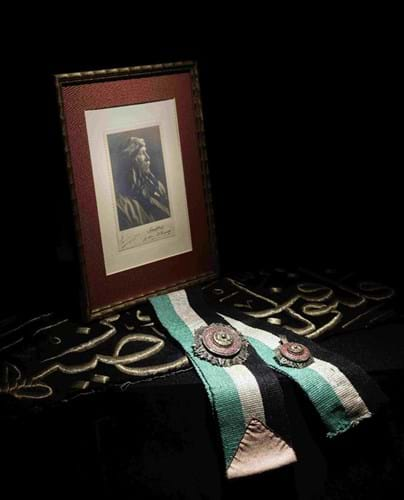
The order of Al Nahda, First Class (£7500) and a section of the black and gold kiswah (£7500) plus a signed photograph of their recipient Lord Headley (£1000) sold at Bonhams.
Rowland George Allanson Allanson-Winn, 5th Baron Headley (1855-1935) led an extraordinary life. Born into an aristocratic family, he was a conventional member of the British establishment until his conversion to Islam in 1913, the year he also inherited his seat in the House of Lords.
Known alternatively by his adopted name of Shaikh Rahmatullah al-Farooq, Headley founded the British Muslim Society (1914), was declared bankrupt (1922) and in 1926 was offered the throne of Albania, which he declined much to the disappointment of his wife who promptly left him.
In 1923 Headley completed the hajj – the pilgrimage to the Muslim holy site of the Ka’ba in Mecca. He was perhaps the first Briton to do so legitimately. Before leaving the city, he paid his respects to King Hussein bin Ali of the Hejaz and was given the gifts which were offered at Bonhams Islamic and Indian Art sale in London on October 25.
These were the rare order of Al Nahda, First Class with star, badge and sash – an award first instituted in 1917 to commemorate the Arab Revolt – and a section of the black and gold kiswah which covered the Ka'ba. The latter was displayed on the wall in Headley’s drawing room in Ivy Lodge, Twickenham with a larger piece presented to Woking Mosque.
They sold at £7500 each, followed at £1000 by a signed photograph of Lord Headley wearing the order of Al Nahda by the society photographer Carl Vandyk.


